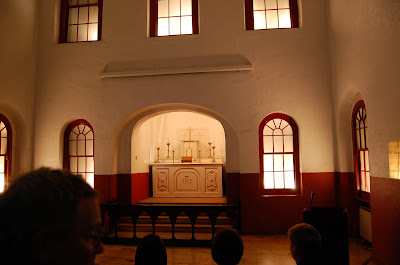Dublin. This city which amazed me so
last summer, how was it to return to it? Dublin is a city that has undergone
tremendous changes the last 20 years, and the Celtic tiger has left its
footmark on the city. Dublin was the Irish city which thought it was
unbeatable…until EVERYTHING went wrong.
But that is not what this post will be
about; I let someone else revel in the darkness of the Irish economy. I want to
tell how my second visit to this city went.
Our accommodation this time was Kinlay
Hostel in Lord Edward Street, which let us be honest, was pretty central and
pretty noisy. 2 minutes away from Temple Bar, and perfect for exploring the
city on foot. I like to walk, but my sister doesn’t, so we had to make a
compromise so I wouldn’t bite her head off.
 |
| Solveig in the hostel |
 |
| A squiky staire-case |
The hostel was like a treasuretrove for someone like me, always on the lookout for extraordinary details. A stairecase, a picture, even a word was enough...I could pursue the perfect shoot just by looking for details.
 |
| Wonder what this tells us about the Irish... |
The first day was a wet day and perfect
for museums. My dad wanted to see animals and mum wanted to see gold, so the
choice was easy: first the museum of natural history and then the national
museum with its archaeological exhibition. On the way there I got a chance to
show them some parts of St Stephens Green and the main street, hoping they
would be able to find their way around town in case we lost them…
But how could I present Dublin properly to my parents? The idea of "important things to see" is not necessarily uniform within my family...so another compromise was made. We ended up with the tourist-solution: hop on-hop off-ticket for 2 days. This meant that we could travel around the city, see what needed to be seen and discover the city in our own tempo. And this was what I did the 17-18th....
*Guiding my family
*Visited some places of importance...like Chapters bookstore
 |
| Heaven on earth for a bibliophile like me... |
*Ended up in Porterhouse....AGAIN
*Visited Kilmainham Gaol...I will try to describe it to you now:
KILMAINHAM GAOL
I never got a chance to visit this last summer, and it had annoyed me since. A place so closely connected to the bloody history of Ireland, to its failed rebellions and to its political growth. I highly doubt my words would do justice to it at all, so I will let the pictures speak and add small comments on them to give you, as a reader, an understandable recount of it.
A few tears were shed when I walked through this place, being told about the different people that sat here for minor or major crimes. It meant a lot to me.
So here ends the first chapter---do you want more? It will come, just be patient








No comments:
Post a Comment